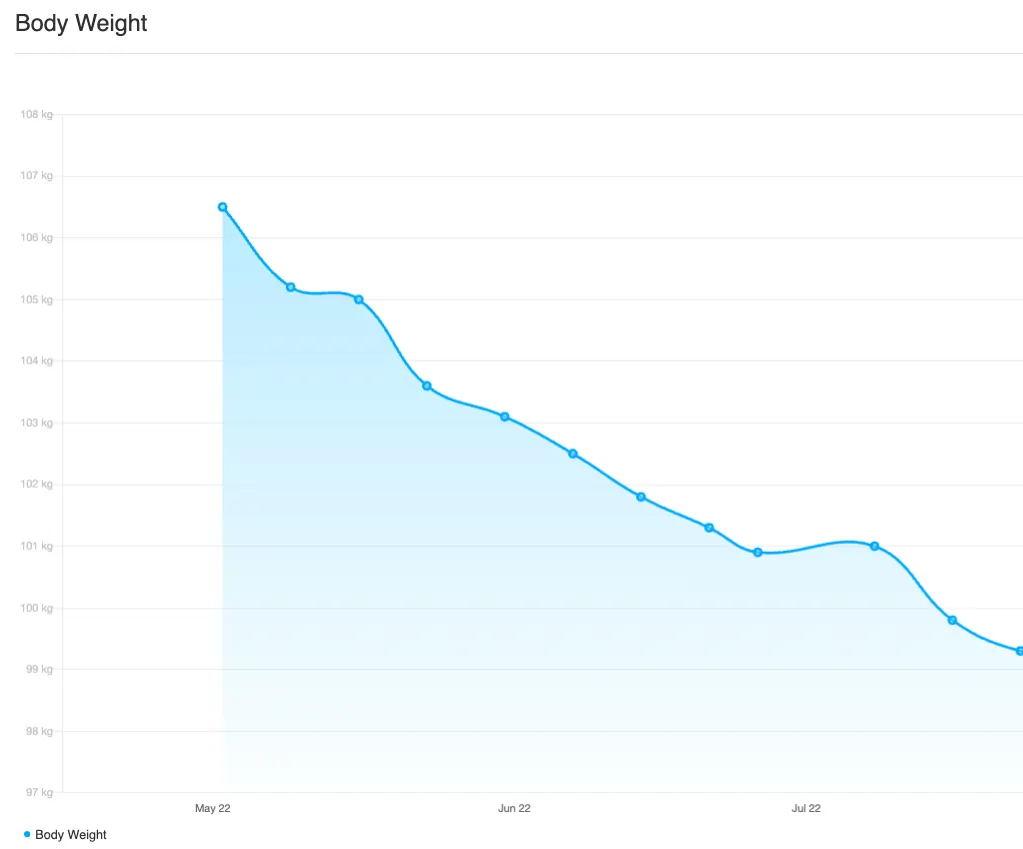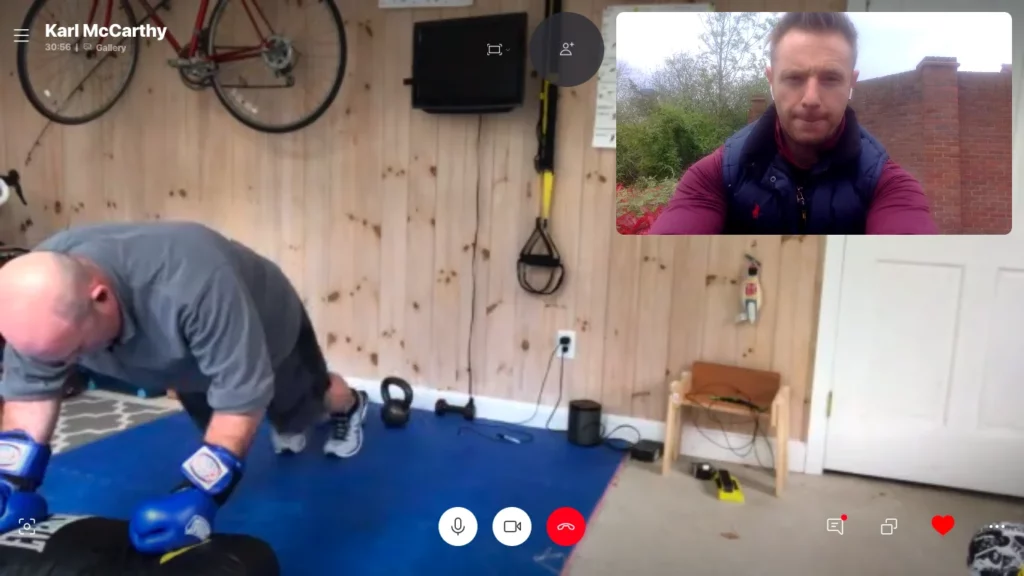
The Problem with weight loss as a goal
If you’re looking for a realistic, and long-term weight loss solution, it can be difficult to know where to start, even more so if you’ve already had multiple unsuccessful attempts at losing weight (which is far too often the case).
A quick search on the ‘best way to lose weight’ can yield hundreds of conflicting results. So rather than try yet another diet trend, you may be considering enlisting the advice and support of a personal trainer to help kickstart your weight-loss journey. But is this an investment in personal training worth making?
Firstly, let’s address a quick misconception. When people talk about ‘weight loss’, in terms of the practical benefits, what they really mean is fat loss, as it’s the loss of body fat that helps us look and feel a way that helps the majority of us with confidence and self-esteem, don’t get me wrong you lose weight with a fat loss goal too, but crucially, it’s an output of the goal, not the goal itself.
Put it this way, life is really about how we feel, will you really ‘feel’ any different at a lower weight if you don’t feel healthy, confident and have freedom of movement? Not really. And if you could have all of those things, would it matter what you weighed? Probably not, at least not in my experience having worked and delivered successful results for my clients.
Being overly concerned about what we weigh is usually a call-back to a time in our childhoods when we struggled with weight or when weight was the sole marker of our success when it came to exercise.
For example, my online personal client Dom, pictured below. Together we decided Dom should adopt a non-restrictive approach to weight loss, through a custom fitness program that I designed for him to be able to prioritise protecting his lean muscle mass and specifically targeting the loss of body fat with no more than a 20% caloric deficit which meant he always maintained his energy levels and ate well above 2250 calories daily. Dom lost -49lbs in 36 weeks with this approach and the best thing is that he achieved it in a sustainable way. Which meant he was able to maintain his results.

The big problem with the traditional approach to losing weight is that ‘weight loss’ can be indiscriminate. To illustrate the idea, what if you enlisted in a weight loss program, and you lost 2lbs one week, but it was all muscle?
Well, conventional wisdom would dictate that we register this as a success, at least on paper. But under closer inspection, you’d have lost hard-earned muscle and as such effectively lowered your metabolism. Because your body no longer needs to burn energy (calories) to maintain the lost muscle. This in turn means that you can now eat fewer calories daily to break even, even though you haven’t lost any body fat (which is the real goal). This finally means that you’ll have less energy, experience more hunger and be more likely to break formation with your plan and reach for calories you never intended to consume undermining your progress.
For this reason, I think it’s clear that the numbers on the scale don’t always tell the full story of what is or isn’t being achieved. If you’re a beginner in fitness, and start following an effective workout program it’s quite common to see achieve fat loss and muscle growth simultaneously. On top of this, it’s entirely normal for weight to fluctuate daily due to any number of factors, including (but not limited to) hydration, salt intake, water retention and hormones. This is important because you can do everything right for a week and still temporarily end up weight more than you started the week, based on the temporary factors outlined above. So gauging your progress solely on what you weigh really isn’t being fair to yourself.
Don’t get me wrong, you will often lose a considerable amount of weight on a fat loss program, but the weight lost on the scale is just one indicative marker of success, or if you will, a side effect or ‘output’ of protecting your muscle mass and directly losing body fat, rather than the goal itself.
So with that cleared up, what are the benefits of working with a personal trainer to tackle fat loss? I see three main benefits in enlisting the expertise of a personal trainer.
What should you look for in a personal trainer to help you lose weight?
1. Expertise
The biggest benefit that a personal trainer can bring to the table is expertise. So you should be on the lookout for both a depth of knowledge and a track record of getting results in fitness, for people like you with similar goals. While it’s perfectly possible to achieve fat loss on your own, an experienced trainer will be able to streamline your efforts to ensure that you’re taking the most linear route to success. By working with a coach, you can cut through the conflicting information, eliminate guesswork and ensure that every workout that you do is bringing you closer to your goals.
In addition to streamlining your efforts, a personal trainer can take your own circumstances into account to build you a completely custom training program. This may be preferable to following more of a cookie-cutter regime that may not be able to adapt to complex or changing circumstances. Including any injuries or restrictions, past experiences and work or family pressures. Striking a balance between your existing responsibilities and new goals makes following the plan consistently far easier, and this consistency will be the key to your success.
2. Outsourcing
Creating comprehensive meal plans, workout plans, tracking everything and creating schedules can actually be quite a lot of work when done comprehensively. If you are busy or don’t have a track record of workout and meal logging, the simple decision to outsource these tasks and decisions could be key to your success. This way, all you need to focus on is turning up to sessions, and implementing the workouts and meals that have been created for you.
3. Accountability & Support
Losing weight as an intention is one of the most emotionally driven goals I’ve ever encountered as a personal trainer. Fraught with challenges of mindset as much if not more than physicality. Having a supportive environment and personal support for your most challenging moments can be the lifeline you need to maintain your momentum and get you across the finish line. It’s not just that though, an engaged fitness coach is also someone to share success with and celebrate everything from the smallest wins to the major achievements it’s this level of personal support that allows the best personal trainers to rival stand-alone accountability coaching services.
Getting support on your weight loss journey
Of course, personal training isn’t the only option if you’d like to get some help in losing weight. Let’s explore some other popular options:
Self-led
It’s perfectly feasible for you to do your own research, create a program for yourself and see it through to its successful completion. The answers are out there and the best coaches aren’t hiding behind secrets either, they will happily tell you what you need to do during a consultation. By working with a qualified fitness coach, it’s the implementation and support that you’re investing in, not just the answers as the effective fitness methodology you should follow.
Weight Loss Groups
Weight loss groups can be a fantastic resource for peer accountability and support. Having a group of people that share similar experiences can be extremely valuable. Just make sure you’re measuring the right things. We’ve already made the distinction between fat loss and weight loss, so make sure distinctions of body composition are acknowledged.
I’d also recommend that before signing up, you ensure you’re comfortable that there is a solution to your problem at the end of the program. It’s been said of weight loss groups that sometimes the original challenge is normalised or habituated, providing a highly empathic environment, but not necessarily one that has the answer to your problems. You’ll get an intuitive feel as to whether this is the case when you’re there.
Boot Camps & Fitness Classes
Fitness boot camps are a fantastic way to get out, get fit and be working out in a relatively low-cost, social environment. I’d recommend these as a part of a weight loss journey as, to me, there is a character-building element in getting out and training outdoors in all seasons. The banana skin here is to make sure you don’t succumb to what we might consider the ‘sweat economy’ of thinking that simply working out as hard as possible, as often as possible and burning as many calories as you can is the best or most linear route to success. Over time this can get a little mechanical and all it takes is the wrong group instructor to change the tone of the session and friendly competition can turn toxic. Also bear in mind, that as humans we can develop blind spots and a bias for the things we’re particularly interested. So beware of the group fitness solution that focuses on one type of training and considers itself a one-size-fits-all solution.
Apps and online workouts
Following your favourite influencers on social media and doing their workouts can be a great low-cost entry to establishing a regular exercise habit. The scale these businesses operate on (millions of followers) mean they can be offered for as little as $1-2 per month. The challenge is personalisation is difficult to operate at that kind of scale, so don’t expect any significant process of personalisation. But don’t get me wrong, the workouts provided are often very high quality and well-polished you just have to be wary of the app offering a series of excellent stand-alone workouts, rather than an actual regime linking workouts together in cohesion.
The other potential challenge here, is being aware that the ‘do what I do’ or ‘here’s what I eat in a day’ narrative might not be the best fit for you. Firstly because sometimes you need a more personalised approach to your goals. Secondly what you see on social media doesn’t always reflect day-to-day reality due to the curated nature of the platforms.
Further to that, what someone does now is not necessarily what they did day-in-day-out to get to their current standing. There is a lot of pressure to entertain on social media, and sometimes what really works is a little too repetitive and boring for the algorithms but that doesn’t mean it doesn’t work. Remember in the final analysis results in fitness are built on the fundamentals.
Personal training options
Even within the realm of personal training, you have three main options:
In-person
The classic, and original personal training service. This usually involves a one-on-one training session with a personal trainer. The big advantage here is that this is going to be the best way to have real-time coaching on the nuance of technique. It’s also a proven way to get the most out of every single workout because there is literally someone there asking you for your best. The banana skin here is that not all trainers are created equal nor will every great trainer’s personality be a good fit for yours, so ask for a consultation or trial session to see if you gel.
Another consideration when it comes to personal training is that sometimes the level of service you get can be limited to the time you spend with the trainers themselves. Meaning there isn’t a lot of follow-up on your efforts outside of the scheduled training sessions, nor on what you’re eating.
Unfortunately, this is because you’re being charged hourly for their time. Of course, great service providers will overdeliver in this realm for you, but it’s a good idea to ask what you can expect between sessions. Because if you really need a trainer there with you to work out, and you want to work out frequently that could get rather expensive quite quickly.
Online Personal Training as a Program
Online personal training programs are best thought of as a blueprint to follow with support outside of your actual workouts. This means that in theory you will be delivered a personalised road map to the successful completion of your fitness goals.
Often with a full meal plan, and nutritional support. Plus have a direct line to your chosen coach for support, advice and course correction. It’s a fantastic blend of expertise and support, and accountability.
What you miss in actually having the personal trainer there with you, is made up for in the overwhelming availability of your coach. Particularly when you are offered instant messaging support. Just like all of the other options, not all services will be the same level of quality, but theoretically online personal training offers a great route to the successful completion of your goals, and will particularly fit anyone that is busy, short on time, travels frequently and needs to remove guesswork but is happy to carry out workouts in their own time.
Hybrid or Virtual Personal Training
Since 2019, many virtual and hybrid personal training options have gained popularity, these can be a blend of the personal training options listed above or a pure video version of one-on-one personal training delivered through an internet video service like Google Meet or Zoom.

Ultimately weight loss is both a simple and nuanced goal. The typical advice of just ‘moving more and eating less’ is technically true, but in my view a little reductionist as well. The nuance is knowing how much to eat, how much to move, for how long and in which ways, because taken to the reductionist solution, surely if you hit a plateau, the solution would be to simultaneously just keep eating less and moving more?
The problem with that is that it can’t be maintained, and quickly leads to burnout and the inevitable rebound effect where the efforts are broken and all progress is undone. This advice means that all over the world today, thousands of people will be reaching out to gyms, trainers and class instructors hoping that this will be the attempt at weight loss that finally works. Maybe it will… but to make that happen it will take a sophisticated solution.
It’s about the toolkit, not just the results
Even if you’re unsure about working with a personal trainer for the long-term, investing in a few weeks or months as a structured coaching program can pay dividends. A good personal trainer will educate clients to equip them with the toolkit to maintain their results not just coach them. Learning the best practices of exercise and nutrition can lay a strong foundation for you to continue your fitness journey into the future, even without the support of a coach.
By learning these first principles early, you can not only achieve your goals quicker, but you can also take steps to maintain your progress into the future, rather than risking gaining lost fat back, as is the case with many more restrictive plans.
My parting advice is, that ultimately the extent to which you need a personal trainer will depend on multiple factors, including what motivates you, and how much accountability you would prefer in whatever direction you decide to move forward in. Make sure the solution you choose is going to be maintainable because the true measure of success at the end of any weight loss program will be the quality of your decisions the day after it finishes, that’s how you know what you’ve achieved is maintainable.